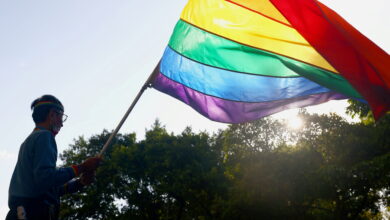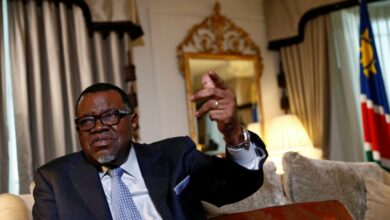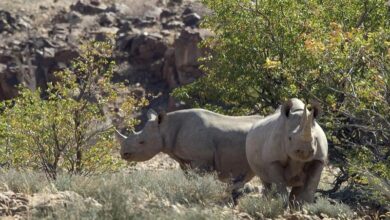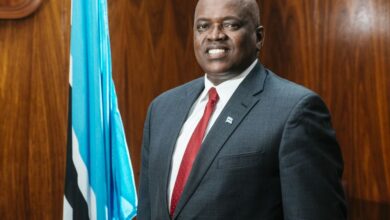Namibia
Namibia, in long form the Republic of Namibia is a country located in Southern Africa. Formerly known as South West Africa, German colony (1884-1915) and then protectorate of South Africa, Namibia has been an independent state since March 21, 1990. It is bordered geographically to the west by Atlantic Ocean, to the north by Angola, to the south by South Africa, to the east by Botswana and to the northeast by Zambia. Its easternmost limit is less than two hundred meters from the tripoint where the borders of Zimbabwe, Botswana and Zambia meet, on the Zambezi river, at the confluence of the Kwando river. Its density is the lowest in Africa (penultimate in the world). Namibia is a member of the United Nations, a member of the African Union and became, in 2014, associate observer to the Community of Portuguese Speaking Countries (CPLP) during the Dili summit.
Namibia’s history
Prehistory
Around 1500 BC, the ancestors of the Bushmen, the first inhabitants of the country, realize cave paintings. The Bushmen are then joined and driven back to the Kalahari Desert by the Khoïkhoïs. The latter are, in turn, driven back by the wave of Bantu expansion (locally the Ovambos and the Heroes) in the second half of the first millennium.
First colonizers
The Portuguese reach Cape Cross in 1486, they approach the coasts of the region from 1550, but they prefer to settle further north, in the territories that will constitute Angola.
From 1680, Dutch settlers settled on the coast. They will however favor the Cape region and the fertile lands, further south, in what will become South Africa. Between 1793 and 1803, the Dutch were driven out by the British, but the Afrikaner populations remained. In 1793, Walvis Bay, the only deep water harbor on the Namibian coast, was annexed by the Cape Colony; it was ceded to the British in 1878, who kept it until 1910. It remains the main maritime access route to Namibia. From the end of the 1820s, the Rhine missionaries (German Lutherans) established the first mission posts in the territory. The village of Wupperthal (en) was thus founded in 1829 by the Rhineland Mission. Missionaries find the country occupied by Heroes and Namas in constant war and seek to ensure the protection of either the British or the Germans. Between 1836 and 1884, the Transgariep was gradually discovered by British and German explorers. In parallel, between 1840 and 1870, the Oorlams of chef Jonker Afrikaner dominated Hereroland and Damaraland. In 1860, the city of Keetmanshoop was founded by German missionaries and settlers.
German colonization
In 1884 Lüderitz was founded by a German merchant from Bremen. The territory between the Kunene river and the Orange river becomes the protectorate of German South West Africa. In 1885, Heinrich Göring became governor of the new German colony and began to sign treaties with local people. In 1894, Swakopmund was founded on the Atlantic coast about fifty kilometers north of the British enclave of Walvis Bay, the only deep-water port on the coast. In 1904, native Heroes rose up and were massacred by the Germans under the command of General Lothar von Trotha. Concentration camps were created, like those set up by the British in South Africa during the Second Boer War. In South West Africa, the Herero population is thus reduced, in a context of deplorable hygiene, famines and especially of the order of the German colonial administration to exterminate all the Hereros, from 80,000 to 15,000 individuals . Some 10,000 Namas were also killed. This massacre of Heroes and Namas is considered the first genocide of the twentieth century.
From the South African mandate to the occupation under UN surveillance
In 1915, the German colony was conquered by the troops of the Union of South Africa during the First World War. In 1920, by decision of the League of Nations (SDN), South West Africa came under British mandate and therefore from South Africa. In 1946, South Africa asked for the annexation of South West Africa to the United Nations, successor to the League of Nations. In 1949, the constitution of South West Africa was revised by the government of Daniel François Malan who brought the National Party to power in South Africa a year earlier. Direct representation of the territory in the South African parliament is now ensured by six deputies and four senators, while guardianship of the indigenous populations is now the sole responsibility of the Pretoria government. In 1959, the massacre of Old location, a district reserved for blacks in Windhoek, killed 57 people during a protest demonstration against the establishment of apartheid. In 1960, on the sidelines of work at the UN, the Union of the People of South West Africa, better known by its English acronym: SWAPO (South West Africa People’s Organization), was first formed in a trade union form. This organization is gradually establishing itself as the leader for resistance to the South African occupation and access to independence. From 1966, the UN organized external surveillance of the territory. The general assembly creates a special committee within the framework of a resolution adopted on October 27. This body manages the territory’s international relations as well as its cooperation policy. In 1967, SWAPO guerrillas against the South African presence began. In 1968, South West Africa was renamed Namibia by the United Nations. In 1971, the International Court of Justice recognized the illegality of the South African presence in Namibia.
On 12 September 1973, in its resolution No. 3111, the United Nations General Assembly recognized SWAPO as “the sole and authentic representative of the Namibian people”. At that time, John Vorster, the Prime Minister of South Africa abandoned the objectives of the Odendaal report and decided, as part of his policy of détente with the African countries, to embark on the path of self-determination of the territory “Including that of independence”. He will thus make Namibia a field of political experimentation whose results he intends to reuse for Southern Rhodesia then led by Ian Smith (results which served as a model for South Africa itself in the 1990s). On April 24, 1974, the election of the legislative assembly of South West Africa was won by the national party of South West Africa, already winner of this election in 1950, 1953, 1955, 1961, 1965 and 1970. It will be the last election where only whites from Namibia will have the right to vote. In November 1974, the Legislative Assembly of South West Africa, dominated by the National Party of South West Africa, invited all authorities in the territory, including tribal authorities and representatives of black political parties, to participate in the two-year constitutional talks at the Turnhalle conference from September 1975 to October 1977; SWAPO and SWANU had declined the invitation.
In July 1975, John Vorster’s Bantu administration and development minister, Michiel Coenraad Botha, put an end to a project to relocate the Ovaherero tribes in the Bantustan of Hereroland in the east of the country. In doing so, Botha puts an end to the implementation of the conclusions of the Odendaal report.
On September 1, 1975, the Turnhalle Constitutional Conference began. In April 1976, Andreas Shipanga, one of the co-founders of SWAPO, denounced nepotism, corruption and the ineffectiveness of the movement’s leadership. With 2,000 of his supporters, including Nathaniel Maxuilili, he tried to take over the party headquarters in Lusaka, Zambia. Sam Nujoma is forced to seek the help of President Kenneth Kaunda to avoid being forcibly removed from office. The rebels are eventually arrested and imprisoned, and charged with collusion with South Africa. Some were released after six months, others were transferred to camps in Tanzania, others still disappeared; Shipanga himself was not released until May 1978. On August 14, 1976, Dirk Mudge, leader of the National Party of South West Africa, called on whites to join blacks on the road to independence. On August 16, delegates to the Turnhalle’s constitutional conference agreed on an interim government to transform the territory into an independent state along the lines of a federation. On 20 December, in resolution No. 385, the United Nations General Assembly refused to recognize the internal development of Namibia and provided “its support for the armed struggle” waged “under the leadership of SWAPO”.
On March 18, 1977, the principle of a three-level government was adopted at the Turnhalle conference: a central power, local authorities based on ethnicity, municipal authorities. The National Assembly would be elected by indirect suffrage through local assemblies. The name of the future state is the subject of a compromise: “South West Africa / Namibia”, at least for the interim period. In May, the Whites vote more than 60% for the Turnhalle’s proposals and accept the principle of independence. In August, the management of the Walvis Bay enclave (attached since 1971 to the authorities of the Cape province) is transferred to the South African government and is thus withdrawn from the independence process. In September, Dirk Mudge came into conflict with the leadership of the National Party of South West Africa, chaired by A. H. du Plessis, who wanted to keep apartheid laws. Put in the minority by a narrow margin, Mudge and eighty of his supporters left the party in October and created the Republican Party. In October, the new South African administrator, Martinus Steyn, a judge with a liberal reputation, repealed the segregationist law on mixed marriages and then that on immorality. Internal controls are abolished throughout the territory except the diamond zone (where they are still in force today) and the northern border. On November 6, Mudge entered into an alliance with ten other ethnic movements, including Clemens Kapuuo’s NUDO, to form the Democratic Turnhalle Alliance (DTA), whose presidency was entrusted to Kapuuo.
On March 27, 1978, the president of the DTA, Clemens Kapuuo, was assassinated by unknown persons. SWAPO, which he fought very hard, is accused. This assassination provokes violent clashes across the country between Ovambo of SWAPO and Hereros of NUDO. A climate of insecurity unknown until then settles in the country and affects all communities. On May 4, the South African army launched a deadly raid on a SWAPO training camp in Cassinga, Angola (867 dead and 464 injured). On September 29, the United Nations passed resolution 435 demanding the withdrawal of South Africa and the independence of Namibia. In December 1978, the first elections open to whites and blacks according to the “one man, one vote” principle, boycotted by SWAPO and not recognized by the United Nations, were won by the Turnhalle Democratic Alliance. A Namibian constituent assembly is set up. On May 21, 1979, the former Constituent Assembly of South West Africa, which became the National Assembly of South West Africa, passed the law on the total abolition of racial discrimination. On the same day, Windhoek became the seat of the country’s political administration (with the exception of the police, the army, the judiciary and foreign affairs). On July 11, all public places are open to people of color and an anti-discrimination law is promulgated. The last legislative vestiges of racial segregation are thus swept away. At the end of the year, a general agreement was adopted on the creation of a demilitarized zone on either side of the northern border, but without success. In April 1980, the new South African administrator, Gerrit Viljoen, promulgated the new constitution. The police and the local army are now under the control of the assembly. On July 1, the first government of South West Africa / Namibia was put in place with an eleven-member council of ministers chaired by Dirk Mudge.
On January 18, 1983, the Namibian cabinet resigned following the refusal of the South African administrator, Danie Hough, to promulgate a law relating to Namibian legal holidays. The National Assembly is dissolved and the South African administrator combines executive, administrative and legislative powers. In June 1985, an interim government and an assembly were replaced by South Africa. In 1988-1989, agreements were signed under the aegis of the United Nations for a transition towards the independence of South West Africa / Namibia. In 1989, SWAPO won the first general elections in which it participated.
Independence
On March 21, 1990, Namibia became independent. Sam Nujoma is the first president of Namibia. SWAPO is in the majority and its representatives direct from the country. In 1992, the first post-independence municipal elections took place. In 1994, the South African enclave of Walvis Bay (the country’s main port) was ceded to Namibia. In 2005, Sam Nujoma hands over to his successor Hifikepunye Pohamba. He is a follower of Sam Nujoma and one of the founders of SWAPO. SWAPO remains in a dominant position in the National Assembly. Hifikepunye Pohamba was re-elected for a second term in 2009, he became one of the winners of the Mo Ibrahim Prize for his governance of the country, then in December 2014, his prime minister was elected president, and succeeded him in 2015. In 2019, parts of Namibia are facing the worst drought in sixty to ninety years, when no rain has fallen in two years and most of the livestock have perished. Authorities declare a state of natural disaster in May and request international assistance: “The livelihoods of the majority of Namibians are at risk, especially those who depend on farming activities,” said Prime Minister Saara Kuugongelwa- Amadhila. In late 2019, President Hage Geingob was re-elected for a second term with a falling score. SWAPO has been in power since 1990.
Namibia’s politics
Namibia is a parliamentary republic. The President of the Republic is elected by direct universal suffrage for a five-year term renewable once. An exception was made for the first president, who had not been directly elected for his first term, because he had been appointed by the National Assembly. He is the head of the executive. The Prime Minister is appointed by the President of the Republic.
Namibia’s economy
Falling commodity prices and a persistent drought caused the country’s gross domestic product (GDP) to fall in 2017 and 2018 and caused unemployment to rise.
Mining activities
The country’s main resource comes from its subsoil and its numerous mines of uranium, copper, silver and diamonds. Thus, diamond production represents some 40% of gross domestic product (GDP), followed by the fishing industry. In the other sectors, Namibia remains dependent on its South African neighbor.
Tourism
Due to its natural heritage and wildlife, Namibia is characterized by an active sport and recreational hunting sector. This activity attracts many foreign hunters who perpetuate the culture of the trophy. This activity is often denounced for the threat it poses to the preservation of wildlife and environmental balance.
Namibia’s demography
The population is mainly black Bantu with white minorities, Afrikaner and German (7%), Chinese (2%) and mestizos (6.5%). In total, the population amounted to approximately 2.1 million inhabitants in 2011 for 842,000 km2. Namibia is one of the driest and least populated countries in the world. It is the second least dense country in the world after Mongolia. It is the Ovambo ethnic group which is in the majority within the Bantu and which monopolizes political posts. Bushmen, of Khoisan language, form the indigenous population but are very minority, even if the Namaquas are close to 200,000. Since 1990, the country has attracted German investors who settle in Namibia to work in the tourism or trade sector.
Namibia’s education
According to official figures, for the year 2005, the literacy rate reaches 80% and more than 90% of children are in school. Namibia has three universities, all based in Windhoek: University of Namibia, Namibia University of Science and Technology International University of Management.
Namibia’s language
The most widely spoken language is Oshiwambo, which concerns 48% of Namibian speakers (native speakers). The Khoikhoi language comes second with 11% of speakers on par with the Afrikaans language spoken by 11% of the population. The Kwangali language is spoken by 10% of the population. Although English is the official language, it is only spoken by less than 1% of the population as a mother tongue, and 7% among the white population, but it is often poorly spoken, despite compulsory education (which is however recent). The German language is also present on the territory; it is spoken in particular by the descendants of the Germanic settlers (around 30,000 people), by German-speaking immigrants and it is also spoken in the second language by 45,000 Namibians, especially in the region of Swakopmund and in the region of Caprivi. The küchendeutsch is a German sabir spoken by 15,000 black African people. German is therefore spoken, to varying degrees, in Namibia by at least 100,000 people. The presence of Portuguese on Namibian soil is explained by the country’s proximity to Angola. Namibia is a very linguistically heterogeneous country. Indeed, in addition to these languages of European heritage, there coexist eight languages and more than twenty main dialects (silozi, otjihero, setswana, damara-nama, oshiwambo…).
-
Namibia

Namibia’s Supreme Court Recognises Same-Sex Marriages Formed Elsewhere
Namibia’s Supreme Court on Tuesday passed a ruling that recognizes same-sex marriages contracted abroad between citizens and foreign partners from…
Read More » -
Namibia

Namibian President Hage Geingob Announces Relaxation Of COVID-19 Restrictions
Namibian President Hage Geingob on Tuesday announced wearing masks in public places will no longer be mandatory in the country,…
Read More » -
Namibia

Namibian Gov’t Aims To Vaccinate 750,000 People Against COVID-19 By September End
Namibian Health Minister Kalumbi Shangula on Monday said the government aims to vaccinate around 750,000 people against COVID-19 by September…
Read More » -
Namibia

Namibia: President Hage Geingob Thanks China And India For Vaccine Donations
Namibia’s President Hage Geingob on Wednesday lauded China and India for their vaccine donations, reported CGTN Africa. “It is in…
Read More » -
Namibia

Namibia: Rhino poaching Cases Falls By Over 60 Percent On Tougher Policing, Penalties
Namibia’s Ministry of Environment and Tourism said rhino poaching in the country fell 63 percent year-on-year due to intensified intelligence…
Read More » -
Namibia

Namibia: President Hage Geingob Confirms Lockdown To Be Lifted In Phases
Namibia’s President Hage Geingob on Thursday said the government will begin to ease nationwide restrictions on movement from next Tuesday,…
Read More » -
Botswana

Botswana President Mokgweetsi Masisi In Self-Quarantine After Namibia Visit
Botswana’s President Mokgweetsi Masisi has gone into self-quarantine for 14 days after returning from a trip to neighboring Namibia, the…
Read More »

